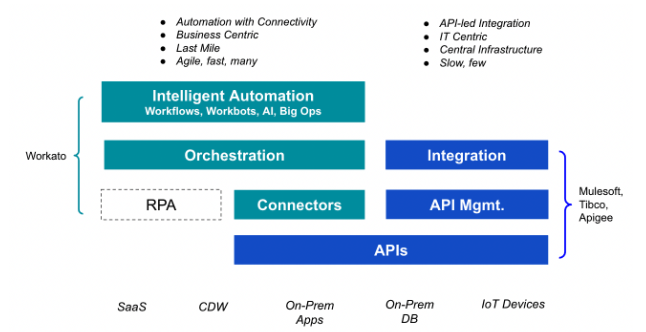Salesforce’s acquisition of Mulesoft at an astounding 16x forward multiple is a strong indicator of the significant and growing role of Integrations in digital transformation. The rationale behind the deal—unlocking data across legacy and cloud apps to enable connected customer experiences at every touch point—makes perfect sense. Congratulations to the Mulesoft and Salesforce teams!
We’ve received many questions about what this means for the integration space and for vendors like us, so I wanted to write a brief note here to speak to that. While this space has a history going back 30 years, with generations of companies like TIBCO, BEA, Informatica, and Mulesoft, it never has been a more exciting time for the category. The exponential increase in applications and devices has resulted in an outbreak in the complexity and diversity of use cases. The modern digital integration platform must support:
- More dynamic integrations across thousands of apps, services, devices, and legacy systems.
- More diverse use cases including data and app integration, workflow automation, intelligent technologies (AI/ML), IoT, and chatbots (in the context of apps like Slack and Microsoft Teams).
- More collaboration between business and IT. Digital transformation is, after all, a team sport. The more different skill sets can be involved, the better the result will be via agile refinement.

Discover how Workato can transform your business processes
Schedule a demo with one of our automation experts to see our low-code/no-code UX in action and to better understand how your team can leverage our platform.
What does this deal mean?
Given all of this, where do products like Mulesoft and Workato fit, and what does this acquisition mean for Workato?
While Mulesoft and Workato play in the same broader integration and automation space, we have distinct centers of gravity.
Mulesoft started in the early 2000s with a strong focus on unlocking legacy apps, connecting them with the emerging cloud apps, and enabling the legacy capabilities as microservices. Their focus has been on publishing APIs and creating composite services on top of them. They have done a terrific job of creating a thriving developer community.
At Workato, we believe these problems have been well addressed by the likes of Mulesoft, Tibco, and Apigee. Workato stands for “work automation”. We created Workato to address the huge and growing gap we saw in enabling pervasive Intelligent Automation use cases. Our focus has been on the consumption of APIs. Workato acts as an orchestration platform that provides connectivity and enables workflow, workbot® (e.g. with Slack and MSFT Teams), AI (e.g. with AWS Sagemaker) and Big Ops (e.g. with Snowflake or Tableau) Intelligent Automation use cases. Together, Mulesoft and Workato cover the entire spectrum of IT-centric (central infrastructure) and Business-centric (last mile) integration and automation use cases. Workato complements Mulesoft as it adds fast and agile support for the many automations the business requires today.
While customers sometimes use Workato for legacy systems integration (and Mulesoft Composer for automations), more often we are both used within the same company. In a typical scenario, developers and integration specialists use Mulesoft to create, compose and make available APIs. They take on the toughest legacy integration challenges. Workato then expands the reach to more general IT resources (e.g. Salesforce developers and administrators) as well as operations experts who are intimately familiar with the business processes. Using thousands of available Workato connectors and re-using the APIs created by their more technical counterparts, this much larger pool of resources is now able to orchestrate innovative business automations.
Finally, from a customer perspective, integration and automation platforms are, at their core, a neutral technology that connects and orchestrates between disparate apps across large app ecosystems like Salesforce, Workday, ServiceNow, Microsoft, Oracle, and SAP. Thus, another factor to consider when crafting your integration and automation strategy is the diversity of your app ecosystems.
These are certainly exciting times for the digital business movement and the evolution of the tools required to support that.

